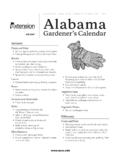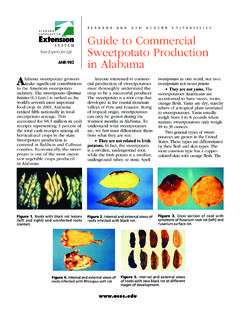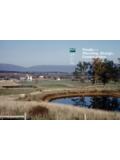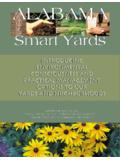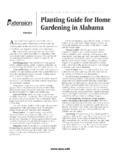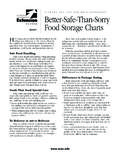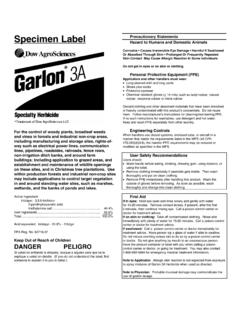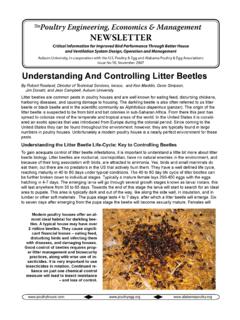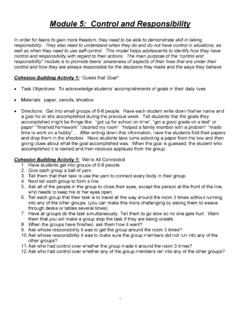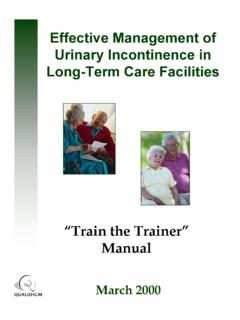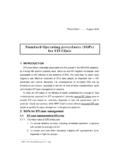Transcription of ALABAMA A&M AND AUBURN UNIVERSITIES …
1 Figures 1 & 2. Doe s Reproductive TractUNP-107 UNP-107 UNP-107 UNP-107 UNP-107 ALABAMA A&M AND AUBURN UNIVERSITIESB iology of reproduction is considered a primarytrait of economical importance inanimal production systems. Within thiscontext, there is a need to adequatelymanage the reproduction of bucks anddoes to increase reproductive efficiencyand herd production. Throughreproductive management, goat herdsmay improve production levels. Inorder to understand and manipulate thereproductive processes of goats, it isimportant to be aware of theirreproductive systems and 's Reproductive SystemAs seen in Figures 1 & 2, a doe'sreproductive tract is composed of thefollowing:OvariesOvaries are almond-shaped, paired,and located on each side of the pelviccavity. They produce the ova or femalegametes and sex steroid hormonessuch as estrogen and are responsible for thedevelopment of the secondary sexcharacteristics of does and the physicaland behavioral changes that doesdisplay during heat.
2 Progesterone isresponsible for changes in the uterineenvironment for embryo implantation,as well as for maintaining pregnancyand promoting mammary gland growthand development during are tiny, convoluted tubeslocated on each side of the uterus thatconnects the ovary to the uterinehorns. The oviducts are divided intothree distinct segments that transportcycle or days before parturition. Theuterus separates itself from the vaginathrough a cartilaginous structurenamed the cervix is a fibro-cartilaginous-likestructure composed of three or fourcartilage tissues named rings. Thecervix connects the uterus with cervix has an anterior and aposterior opening or OS. The cervixremains closed; however, it opensduring heat under the influence ofthehormone estrogen to facilitate thepenetration of the sperm cells. Thecervix is also opened during parturitionfor the passage of the fetus. Duringpregnancy, the cervix enlarges like theuterus.
3 The inner layer of the cervix hassecretory cells that produces a thickmucus, or "plug," that accumulatesduring pregnancy to protect the uterineenvironment against pathogens orinfectious agents and foreign vagina is a large and tubularelastic structure 9 to 15 cm in is located between the cervix andvulva. The vagina is the copulationorgan of the female, receiving thepenis during mating, and it expandsduring vulva is the external genitaliaconsisting of the vestibule and thelabia. The vestibule, generally 3 cm inlength, is common to the urinary andgenital tract. The vestibule joins thevagina with the urethral labia consists of the labia majoraand minora, the outer and inner foldsof skin outside the vagina. The labia2 ALABAMA Cooperative Extension Systemthe ova and spermatozoids in oppositedirections. Once the ova are releasedfrom the ovary during ovulation, theyare captured in the oviduct.
4 Theoviduct is the site where the ova arefertilized. In a segment known as theampulla. The oviduct is the site wherefurther capacitation of thespermatozoa doe's uterus is bicornuate, whichmeans that it has two long cornus orhorns that connect the uterine body tothe oviducts. Does are known to have asmall uterus, generally 3 cm in lengthand 2 cm wide. The uterus is a smooth,muscular organ that stretches duringthe pregnancy along with the growth ofa fetus or fetuses. The uterus protectsand provides nourishment to theembryo and fetus during uterus is also the site where thesperm cells reach maturation orcapacitation, and where the embryomigrates and develops throughout thepregnancy until endometrium, or internal layer ofthe uterus, is formed by glands thatsecrete endometrial milk that nourishesthe embryo. The endometrial glandsalso secrete prostaglandin F2 orPGF2 , a hormone responsible for theluteolysis or degradation of the corpusluteum (CL) at the end of the estrousFigure 3.
5 Doe s Reproductive TractBiology of reproduction of Goats 3 Table 1 Doe's Reproductive Organs and FunctionsOrganFunctionsOvariesProduces the ovaProduces estrogens (Graafian follicles)Produces progesterone (Corpus Luteum or CL)OviductsTransports spermatozoa and ova, further site of spermataozoacapacitationSite of fertilization of the ovaUterusSite for spermatozoa capacitationEmbryo and fetus retention and nourishmentCervixTransports spermatozoaProtects the uterus against foreign microorganismsVaginaCopulation and birth canal; site of sperm deposit during natural matingVulvaExternal genitalClitorisExcitatory organ of the doemajora is homologous to the scrotumin males, and it is the visible externalportion of the female clitoris is located in the lowerportion of the vulva. It is theexcitatory organ of a doe'sreproductive StructuresThe female reproductive tract is locatedin the pelvic cavity, and is supported bythe broad ligament.
6 This ligamentsupports the ovaries, oviducts, anduterus. Blood vessels and nerves passthrough the broad ligament to supplyblood to the female 's Reproductive TractThe buck's reproductive system (seeFigures 4 and 5) consists of testes(testicles), scrotum, spermatic cords,accessory glands, penis prepuce, andthe male duct testes or testicles are oval-shapedand paired. They are the mainreproductive organs of a buck. Thetesticles are housed in the are symmetrical in shape andsize, elastic to firm in consistency, andmobile in the scrotal sac. The primaryfunctions of testicles are to producespermatozoa or male germ cells in theseminiferous tubes, and to secretesteroid hormones (testosterone) bythe Leydig cells. A buck within 8-144 ALABAMA Cooperative Extension Systemmonths of age should have 25 cm ofscrotal scrotum is the sack-like pouchformed by the skin that is responsiblefor protecting the testicles and theepididymis that is located in theinguinal region between the legs.
7 Thescrotum also aids in thethermoregulation of the is the first external duct of thetesticles that is divided into three parts:the head, body, and tail. The epididymistransports, matures, nourishes, andstores spermatozoa produced in thetestes. It is the site where thespermatozoa acquire CordThe spermatic cord is composed ofmuscles and fiber tissues and a portionof the vas deferens. The cord connectsthe testicles to veins and arteries thatirrigate the testicles in conjunction withthe scrotum to position the testiclesoutside the body, and to help regulatethe temperature of the DeferensThe vas deferens, or ductus deferens,are a pair of ducts tied to the tail orcauda of the epididymis. They passalong the spermatic cord to the pelviccavity where they merge with theurethra. The vasa deferentia transportspermatozoa from the epididymis tothe urethra is a duct common to theurinary and reproductive tracts.
8 A distalportion of the urethra is connected tothe urinary bladder. The distal portion isinserted in the penis and serves indischarging urine and GlandsThe accessory glands are located nextto the urethra and consist of thevesicular, prostate, and bulbouretralsglands. The accessory glands areresponsible for producing seminal fluidthat nourishes, serves as a buffer, andprovides other substances needed forthe motility and fertility ofspermatozoa. The spermatic fluid andspermatozoa combined form thesemen. Accessory gland fluids emptyinto the 4 & 5. Genital Tract of Male GoatsBiology of reproduction of Goats 5 PenisThis organ is responsible for malecopulation and deposits semen in thefemale tract. The corpus spongiosumand cavernosum are expandable tissuesthat enlarge and fill with blood whenarousal occurs. In this excitatorystate, the penis is erect, facilitatingcopula and the ejaculation of semenin the female genital prepuce is the sheath or foreskinthat protects the temperature inside a testicle is2 C below body temperature.
9 In coldTable 2 Reproductive Organs and Functions of Male GoatsOrganMajor FunctionsTestis or TesticlesProduce spermatozoa and testosteroneScrotumSupport, protect, and regulate the temperature of the testiclesSpermatic CordSupports and regulates the temperature of the testiclesEpipidymisConcentration, nutrition, storage, maturation, and transport of thespermatozoaVas deferensTransports spermatozoaUrethraTransports spermatozoa and urine, and forms semenAccessory GlandsProduction of seminal fluids to provide energy, buffer, and nourishmentof the spermatozoaPenisCopulation organPrepuceEncloses free end of penis for penetrationweather, the testicles rise near theabdominal cavity; in hot weather, themuscular relaxation permits testes toswing and hang down from the responsible forthermoregulation are the musclescremaster, dartus and the plexuspampiniform. This relaxed statemaintains optimum temperature for thespermatogenesis to process and thespermatozoa to survive.
10 A buck's lowfertility rate is attributed toenvironmental conditions and theincapacity to regulate the optimumtesticular ALABAMA Cooperative Extension Systemprocess because it reduces theannualbreeding season and limits theopportunity for producers to markettheir kids phenomenon of photoperiod isregulated by melatonin, a hormoneproduced by the pineal gland. Thepineal is an endocrine gland located inthe brain. The reduction in daylightexposure stimulates the optic nerve ofthe retina, which, in response,stimulates the cells of the pineal glandto secret melatonin. Higher levels ofmelatonin trigger a sequence ofpositive and negative feedbackinvolving several endocrine glands andthe increased levels of the gonadotro-pin-releasing hormone (GnRH) gener-ated from the hypothalamus, a glandlocated in the brain, triggers doecyclicity. The GnRH stimulates the cellsof the anterior pituitary, or hypophysis,located at the base of the brain to se-crete the follicle stimulating hormones(FSH) and the luteinizing hormone(LH).
